
Plague Quarantine Page Menu: 1 2 3 4 5 6 7 8 9 10 11 12 13 14 15 Next>>
Golden Age of Piracy Maritime Quarantine For Plague, Page 6
Quarantine at the Mediterranean Lazarettos
Incoming people and goods were believed to carry the plague virus so both were required to serve quarantine. As historian Charles Savona-Ventura says of the lazaretto on Manoel Island in Malta, "facilities were made available to have the passengers ...disinfected, whilst clothing and baggage was fumigated in special chambers."1 Each was handled differently, so this section begins by looking at how people were quarantined and then at how goods and letters were processed at the lazaretto.
1 Charles Savona-Ventura, Knight Hospitaller Medicine in Malta [1530-1789], 2015, p. 49
Quarantine at the Mediterranean Lazarettos: People
While methods for quarantining people in the Mediterranean lazarettos was performed in similarly in different places and during different time periods, the specifics could vary quite a bit, making it all but impossible to identify a true 'standard' quarantine procedure. This section is focuses primarily on the how quarantine was handled by the Italian system with references to the Maltese and French lazarettos which were based upon it.
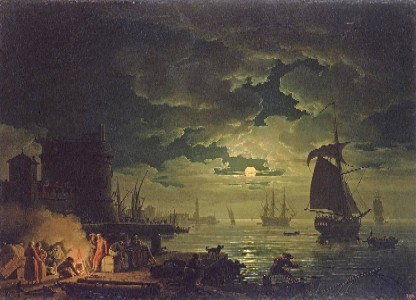
Artist: Claude-Joseph Vernet - Entrance to the Port of Palermo by Moonlight (1769)
People could either serve quarantine in the lazaretto and or aboard the ship in which they arrived. We have already seen from John Howard's account of serving quarantine in the late 18th century that the passengers at Venice during that period were required to go to the lazaretto while the sailors were left aboard the ship during the quarantine.1 There was some variety in how shipboard quarantines occurred. By we of example, on a ship in the sixteenth century at Palermo which was labeled foul: "All persons, except the sick and a sufficient number of seamen to guard the ship, were sent ashore to a place known as the Borgo, where all garments were taken from them and they themselves [were] exposed to the fumes of boiling pitch and afterwards washed with vinegar. Some of the clothing was burned and some washed, aired, and perfumed for fifty days."2 Those who were already ill were sent to the lazaretto. The rudder was removed from their ship so that they couldn't leave and, although it is not explicitly stated, those not ill appear to have been put back aboard to serve their quarantine. This is different than how this procedure was performed later at other locations.
Writing about his own quarantine experience of 1741, Frenchman Jean Jacques Rousseau said that at Genoa, Italy, that "The passengers had the choice of performing it [quarantine] on board or in the Lazaretto, which we were told was not yet furnished."3 Even Howard mentions that the Venetian lazaretto he started in was used to house "the crews of those ships which have the plague on board", which indicates that only crews on suspect vessels could serve out their quarantines shipboard.4
1 See John Howard, An Account of the Principal Lazarettos In Europe, 1791, p. 17-8; 2 John Macauley Eager, "The early history of quarantine", Yellow Fever Institute Bulletin No. 12, March, 1903, p. 22-3; 3 Jean Jacques Rousseau, The Confessions of Jean Jacques Rousseau, Citizen of Geneva, Part the Second, Volume 1, 1790, p. 44; 4 Howard, p. 11
The Shipboard Quarantine Experience
Scottish surgeon Patrick Russell says that during the late 18th century the captain of the ship performed quarantine aboard his vessel with his crew rather than in the lazaretto.1 The 1716 Instructions for the Marseille lazaretto state that ships were "obliged to go straight to their Ships in the Port of Pomegues [an Island off Marseille], where they were to make their quarantine"2. Based on his experiences,
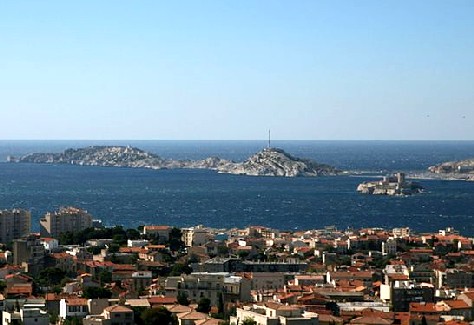
Photo: Arnoldus Borret - Port of Pomègues as Seen From Marseille in 2012
John Howard states that the guardians were to "superintend the quarantines of ships and their companies, on board which they are sent immediately on their arrival, and continue till their discharge; all these have a fixed daily allowance, from the passengers, masters of ships or merchants in whose service they immediately are."3
At Marseille, guards were assigned to an area nearby to be sure that the ship had the correct orders, the crew served their quarantine properly by not coming into contact with other people, even the those on other ships serving quarantine. These guards were forbidden from accepting money or gifts from those they were watching in quarantine.4 Guards similarly watched the crews performing quarantine at Trafaria, Portugal. The 1695 instructions state that crews were to be "met by guards, and there will always be two for each vessel, because while one sleeps, another watches"5.
Howard explains that the guards posted on a ship had increased responsibility because they couldn't communicate with the prior running the lazaretto; they instead reported directly with the Bureau of Health's office. These guards were to "give an account of every thing that happens immediately. They must also take a distinct and minute note of all goods and effects on board without exception, a copy of which they also transmit to the office, in order to prevent contraband goods being clandestinely retained."6 The 1716
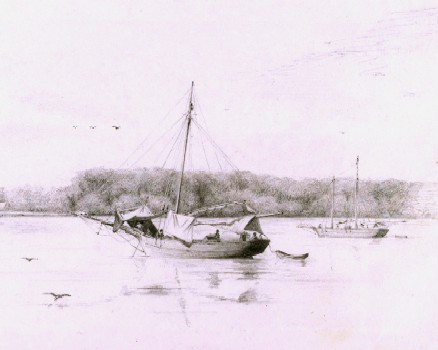
Artist: Arnoldus Borret - Two Sailing Ships in Quarantine (c. 1880s)
Marseille instructions likewise ordered the guards to report everything that happened to those on ships at the Pomegues Port including any transgressions of the rules. Transgressions were punished by adding three to eight days to their quarantine.7
Nothing was to be removed from a ship in quarantine and no one was allowed to come near it unless permitted by a mandate from the office. Those who were allowed to board a ship under quarantine, always had to be in sight of their appointed guardian. The 1716 Marseille Instructions state that those serving quarantine on ships "are forbidden to communicate with the people on other Ships when they are in quarantine, for any reason, even those who are from the same place"8.
The 1695 Rules for Quarantine at the Messina Lazaretto don't have a lot to say about the quarantine experience of those on a boat, although they do mention that licensed vendors could provide food at an established price to the sailors, provided they didn't get too close to the people in quarantine. All transactions took place through the ship's posted guardian.9 At Marseille in 1716 there was a service ship whose captain was to "take care of bringing Provisions to the Ships who are in quarantine"10. The service ship's captain was also charged with keeping an eye on the ship's crew and guard and reporting the things he saw back to the office. If anyone fell ill on the ship, the guardian posted on it was to report this. The Board of Health could then take appropriate action.11 The Marseille instructions said that if a crew member fell ill during shipboard quarantine, that individual was to be brought to the surgeon in the lazaretto who would specify the treatment required.12
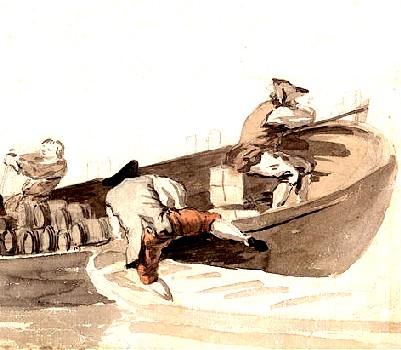
Photo: Samuel Scott - Men Loading a Boat with Casks (18th c.)
At Trafaria, the lazaretto opposite Lisbon, Portugal, the 1695 instructions specify that when a ship in quarantine needed food, the guards aboard were to signal this either using a white flag placed on the main mast during the day or two pistol shots at night followed by lighting a lantern. The guardian of health would then send his Flag Guard aboard their frigate to that vessel and make the necessary arrangements.13 When the guards wanted water, one of the two guards would go "in the small boat to fetch water, [while] the other stays to guard the vessel."14 When the ship wanted water (which almost always meant filling casks), the "flag guard shall order the people of the ship to take their boat to the Fonte da Pipa, getting the water from the spout that is next to the beach with the Flag Guard making them return quickly [after filling their casks] in their boat, following them in his frigate at a suitable distance."15 The instructions noted that this was to be "accompanied by a certificate issued by the health officer assigned by the custodian, to record what had been spent on the frigate"16 so that the ship could be charged for the service at the end of their quarantine.

Artist: Maurice Quentin de La Tour
Jean-Jacques Rousseau (1753)
There is not much information about the what a vessel's crew did during quarantine. When choosing whether to serve his quarantine on the ship he arrived in or in the lazaretto, Frenchman Jean-Jacques Rousseau's response was most telling. "The insupportable heat, the closeness [lack of space] of the vessel, the impossibility of walking in it, and the vermin with which it swarmed, made me at all risks prefer the Lazaretto."17 Rousseau was the only person on the vessel who chose to serve his quarantine on land.
There was little of urgency to do on a ship when she was at anchor. Normally the operation of the ship and those tasks necessary to keep her sailing under varying conditions occupied much of the crew's time as well as giving them purpose. When serving quarantine, however, they were so close to civilization, where freedom, drink and company were more freely available. This would certainly have chafed. Musing on his situation during shipboard quarantine at Genoa, sea surgeon James Yonge wrote, "we lay there at the mole [breakwater] as vessels do at the kay [cay] in Plymouth, one cable astern to the shore, another at an anchor in the haven. It ebbs and flows little or nothing"18. That statement seems to have tedium embedded in it.
Still, most contemporary commentators awaiting pratique only hint at a desire to go ashore. Although this desire is not quite as palpable as suggested in Yonge's statements (possibly because the author's wait was much shorter), Francis Rogers said while they were at the Grand Canary Islands, "The Spaniards made us to wait almost an hour in our boat, before they would give us product [pratique], that is permit us to land, we not having a bill of health from England. At last by the means of the Master of the English ship, who used there and
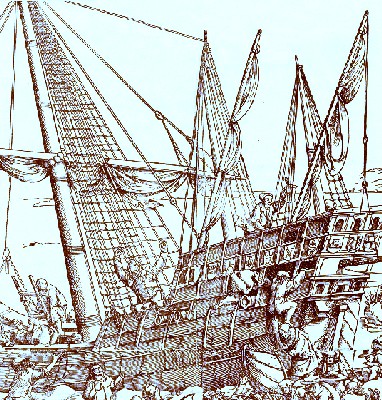
Artist: Reinier Nooms
Men Working on a Ship (c. 1620-30)
came lately from England, satisfying them that we were not sickly there, we were suffered to come on shore"19.
Although he served his quarantine on land, Rousseau's introduction to the arrival of the felucca on which he sailed is one of the more telling: "On our arrival at Genoa, after a long and tedious passage, we were subjected to a quarantine of twenty-one days."20 Other considerations aside, it is not surprising he chose to leave the vessel and serve his quarantine on land.
With nothing pressing to do, sailors were probably kept busy with whatever maintenance tasks were needed to keep the ship running smoothly and efficiently while serving a long quarantine. However, only one account from the period gives any indication that ship work was performed before pratique was received. English navy sailor Samuel Atkins' ship arrived at Livorno, Italy in February of 1681. He explains that on the first day, "Wee heeled and scrubbed our shipps" and on the second, "wee tarred ye ship's sides, and gott up our topgallant masts and yards and sent our boat ashore for water."21 However, they had not even attempted to go ashore before these tasks were completed, so this was technically not performed during quarantine. (It is interesting that they were allowed to go ashore to get water without mentioning an escort. Atkins also mentions ship's captains dining with each other, something that would not be allowed for ships performing quarantine.)
1 Patrick Russell, A Treatise on the Plague, Vol. 2, 1791, p. 395; 2 Daniel Panzac, "Appendix 1: INSTRUCTION POUR LES INTENDANTS DE LA SANTE SUR LES USAGES & COUTUMES DU BUREAU", Quarantines et Lazarets, 1986, p. 133 - translated by the author; 3 John Howard, An Account of the Principal Lazarettos In Europe, 1791, p. 16; 4 Panzac, "Appendix 1", p. 132; 5 Eduardo Freire de Oliveira & Câmara Municipal de Lisboa, Elementos para a historia do municipio de Lisboa, Tomo X, 1899, p. 428, translated by the author; 6 Howard, p. 17; 7 Panzac, "Appendix 1", p. 132; 8 Panzac, "Appendix 1", p. 133; 9 Instruzzioni e gouerno del lazzaretto di Messina per la scala franca, 1695, p. 21 - translated by the author; 10 Panzac, "Appendix 1", p. 131; 11 Instruzzioni e gouerno del lazzaretto di Messina..., p. 28; 12 Panzac, "Appendix 1", p. 126; 13 Freire de Oliveira, p. 431; 14 Freire de Oliveira, p. 428; 15,16 Freire de Oliveira, p. 431; 17 Jean Jacques Rousseau, The Confessions of Jean Jacques Rousseau, Citizen of Geneva, Part the Second, Volume 1, 1790, p. 44; 18 James Yonge, The Journal of James Yonge [1647-1721], 1963, p. 70; 19 Francis Rogers. from Bruce S. Ingram's book Three Sea Journals of Stuart Times, 1936, p. 146; 20 Rousseau, p. 44; 21 Samuel Atkins, "A Sailor's Journal", Colburn's United Service Magazine, Part 1, 1854, p. 206
The Lazaretto Quarantine Experience - Arrival
Prison reformer and lazaretto researcher John Howard provides the most detailed explanation into the routine of people serving quarantine in a lazaretto. Before people could even enter the lazaretto, Howard explained that the custodian or prior "cannot receive persons nor effects to perform quarantine without a mandate from the [Bureau of Health]
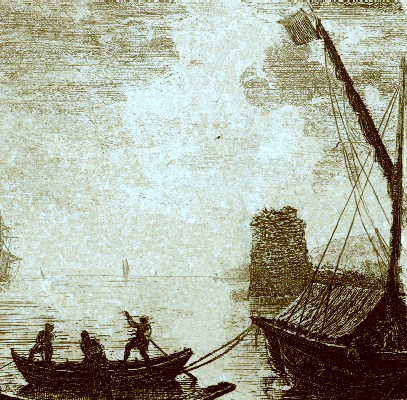
Artist: Claude Lorrain - Sun Rising on the Levant, Le Soleil levant (1634)
office"1. This was likely to preserve the corden santinare if such were in place. When the mandate was received, those going to the lazaretto to serve quarantine were brought there by the boats of their vessel.
Once inside, a lazaretto guardian was assigned to them, just as had been done for those serving their quarantine aboard their vessel. "On the arrival of passengers [the guardian] must see all their trunks, chests, &c. opened, put his hands in every one of them, take a note of the general contents, and if he finds any thing contra band, the prior or custodian must acquaint the magistracy, who determine[s what to do] accordingly."2 Howard adds that "their apartment [in the lazaretto] is assigned... and they begin to count their quarantine from the day after their arrival at the lazaretto, with the precautions and regulations already described."3
Howard does not discuss how the patients were segregated once they were taken inside the lazaretto. As already mentioned, patients labelled 'suspect' were separated from those labelled "infected or foul". Carlo Cipolla describes a 1652 inspection performed at the Genoa lazaretto. Here, the patients were
divided into two separate groups. One group ...was subject to quarantena brutta (ugly quarantine [foul])... [while] the other ...inmates [were] under the purga di sospetto (quarantine of suspicion). These individuals had not knowingly been in contact with infected people or merchandise, but they had either developed strange fevers or had come from areas where cases of plague had been reported.4
The guardians kept people from different
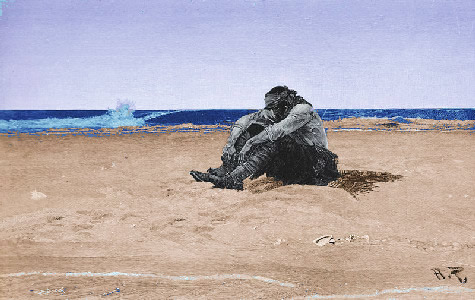
Artist: Howard Pyle (1887)
ships from interacting within the lazaretto. John Howard explains that no one was even "permitted to go without the limits of their allotted apartment, unless accompanied by the guardian, who has his cane to keeps others at a due distance."5
Beginning in 1503, the quarantine system at Venice established four individual lazaretto units where suspect patients were placed, "each [unit] providing ten successive days of quarantine to separate groups of plague suspects. If the disease actually broke out among members of one unit, the entire group returned to the first facility to initiate another complete round of quarantine."6 By the eighteenth century two of the four lazarettos at Venice no longer appear to have been in use. Howard only mentions the new lazaretto (Lazaretto Nuovo) and the old one (Lazaretto Vecchio). Infected patients - both those coming from the sea and land - were put at the old lazaretto. Suspect patients and those who had been infected but were now healed and recovering were put on the new lazaretto.7
In addition to explaining how people were brought to a Mediterranean Lazaretto, Howard explains his own experience. Recall that he chose to serve the
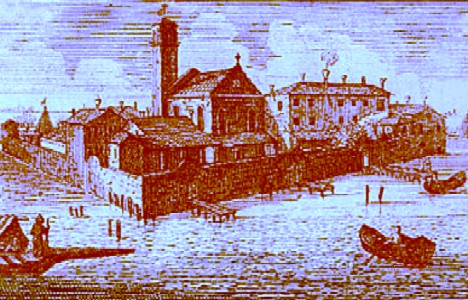
Artist: Francesco Zucchi - Approaching Lazaretto Vecchio, Venice (Early/Mid 18th c.)
full 'foul' quarantine at Venice. He was initially ordered to be admitted to the Lazaretto Nuovo in Venice. He was on the ship he arrived in when
a messenger came in a gondola to conduct me to the new lazaretto. I was placed, with my baggage, in a boat fastened by a cord ten feet long to another boat in which were six rowers. When I came near the landing-place, the cord was loosed, and my boat was pushed with a pole to the shore, where a person met me, who said he had been ordered by the magistrates to be my guard.8
It is interesting that Howard elsewhere says people were brought to the lazaretto via the vessel's own boat rowed by her crew, when he himself was alone in the boat, towed by another boat.
1 John Howard, An Account of the Principal Lazarettos In Europe, 1791, p. 14; 2 Howard, p. 16; 3 Howard, p. 20; 4 Carlo M. Cipolla, Cristofano and the Plague, 1973, p. 28; 5 Howard, p. 16; 6 Guenter B. Risse, Seventeenth-Century Pest Houses or Lazarettos, Jan. 1999, p. 28-9; 7 Howard, p. 16; 8 Howard, p. 10
The Lazaretto Quarantine Experience - Oversight
Just as a guardian was posted on ships where quarantine was being served, so were
Former Custodian's Building Made Powder Magazine
at the Lazzaretto Nuovo, Venice
guardians assigned to groups of people serving quarantine in the lazaretto. John Howard explains that the guardians "are very watchful about the health of their passengers, and give notice to the prior whenever they perceive symptoms of sickness."1 They also kept an eye on the porters who were in charge of airing goods inside the lazaretto, reporting any illness, negligence or transgressions by them to the prior.
Howard says that the prior in charge of the lazaretto at Venice was to visit it twice a day "to see that the passengers are properly served and supplied with necessaries, and that every thing goes on according to the rules and cautions of health."2 In addition, the prior was to see "that quiet and good order be maintained among the passengers and porters, and must not permit gaming, drinking, nor even such exercises and diversions as might produce a mixture of persons in different quarantines, or offend the circumspection of the place."3
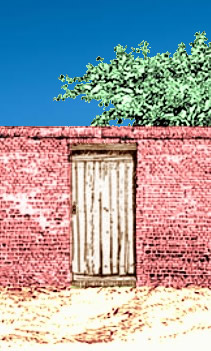
The 1695 Messina rules similarly warn that quarantine in the lazaretto was to be served quietly: "there will be no banquets, games [gambling], or other amusements which may occasion disturbance or scandalous discord."4
This doesn't mean that people were not allowed to move about the lazaretto. Frenchman Jean-Jacques Rousseau said that he was "at full liberty to walk at my ease from chamber to chamber, and story to story; every where finding the same solitude and nakedness [referring to the lack of furniture in the rooms]."5 Rousseau was the only person in the lazaretto, however, so this freedom may not be quite as remarkable as it first seems.
Howard also says the prior was responsible for locking the gates and making sure that the individual 'apartment' doors were locked at sunset. He was to keep the keys on him through the night, not unlocking the doors until sunrise.6 The 1695 Messina rules state that the keys were the responsibility of the lazaretto custodian and, in his absence, the sub-custodian.7 Rousseau doesn't mention who locked the doors, although he does say, "I was shut in by great doors with huge locks"8. The 1716 Marseille rules order a Gatekeeper to be assigned to lock the lazaretto doors at night 'after the Retreat has sounded' and then give the keys to the captain of the lazaretto.9
1 John Howard, An Account of the Principal Lazarettos In Europe, 1791, p. 16; 2,3 Howard, p. 14; 4 Instruzzioni e gouerno del lazzaretto di Messina per la scala franca, 1695, p. 29 - translated by the author; 5 Jean Jacques Rousseau, The Confessions of Jean Jacques Rousseau, Citizen of Geneva, Part the Second, Volume 1, 1790, p. 44; 6 Howard, p. 14; 7 Instruzzioni e gouerno del lazzaretto di Messina..., p. 12; 8 Rousseau, p. 44; 9 Daniel Panzac, "Appendix 1: INSTRUCTION POUR LES INTENDANTS DE LA SANTE SUR LES USAGES & COUTUMES DU BUREAU", Quarantines et Lazarets, 1986, p. 132 - translated by the author;

